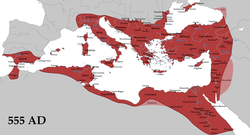Finde den Widerspruch.
Byzantine Empire - Wikipedia, the free encyclopedia
[TABLE="class: infobox geography vcard vevent, width: 290"]
[TR="class: mergedtoprow"]
[TD="class: fn org summary, colspan: 3, align: center"]Byzantine Empire[/TD]
[/TR]
[TR="class: mergedbottomrow"]
[TD="class: fn org summary, colspan: 3, align: center"]Βασιλεία Ῥωμαίων[SUP]
a[/SUP]
Imperium Romanum[/TD]
[/TR]
[TR]
[TD="colspan: 3, align: center"]
[TD="align: center"]
c. 330 – 1204
1261 – 1453
[/TD]
[TD="width: 50, align: right"]
 →
→
[/TD]
[/TD]
[/TR]
[TR]
[TD="class: maptable, colspan: 3, align: center"]
 Solidus
Solidus with the image of
Justinian the Great
(r. 527–565)
(see Byzantine insignia)[/TD]
[/TR]
[TR]
[TD="colspan: 3, align: center"]

The Empire at its greatest extent in 555 AD under
Justinian the Great[/TD]
[/TR]
[TR]
[TD="colspan: 2"]
Capital[/TD]
[TD="width: 50%"]
Constantinople
Coordinates:
41°00′N 28°58′E / 41.000°N 28.967°E / 41.000; 28.967 (modern-day
Istanbul)[/TD]
[/TR]
[TR]
[TD="colspan: 2"]
Languages[/TD]
[TD]
- Greek (official after 620)
[/TD]
[/TR]
[TR]
[TD="colspan: 2"]
Religion[/TD]
[TD]
Roman polytheism until 380.
Christianity/
Eastern Orthodox
(tolerated after the Edict of Milan in 313; state religion after 380)[/TD]
[/TR]
[TR="class: mergedtoprow"]
[TD="colspan: 2"]
Government[/TD]
[TD]
Autocratic absolute monarchy[/TD]
[/TR]
[TR="class: mergedrow"]
[TD="colspan: 2"]
Emperor[/TD]
[TD][/TD]
[/TR]
[TR="class: mergedrow"]
[TD] -[/TD]
[TD="align: left"]330–337[/TD]
[TD]
Constantine I[/TD]
[/TR]
[TR="class: mergedbottomrow"]
[TD] -[/TD]
[TD="align: left"]1449–1453[/TD]
[TD]
Constantine XI[/TD]
[/TR]
[/TABLE]
"The
Byzantine Empire, sometimes known as the
Eastern Roman Empire, was the predominantly
Greek-speaking continuation of the eastern half of the
Roman Empire during
Late Antiquity and the
Middle Ages."





